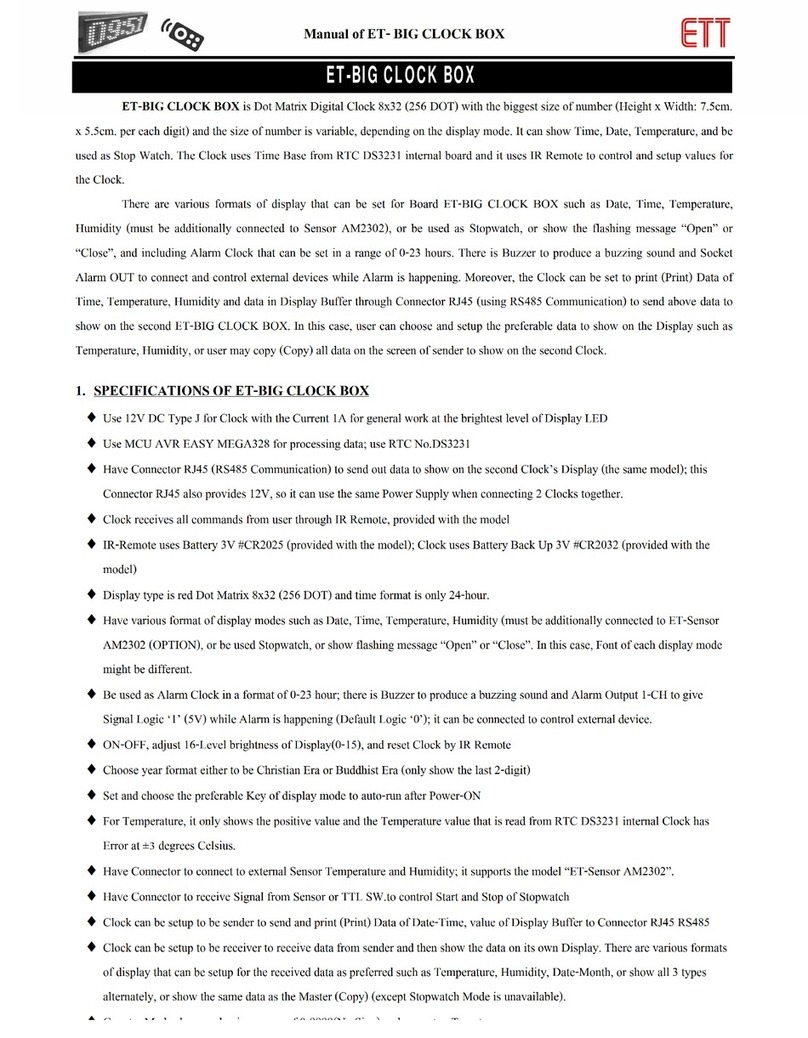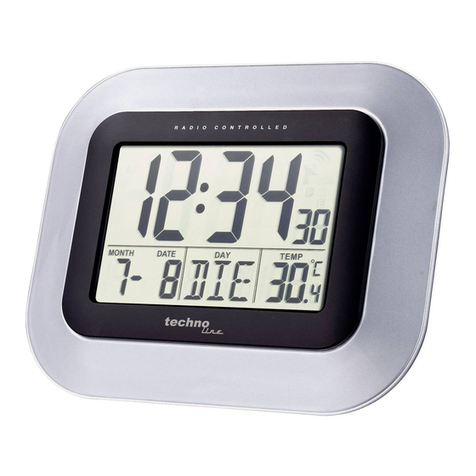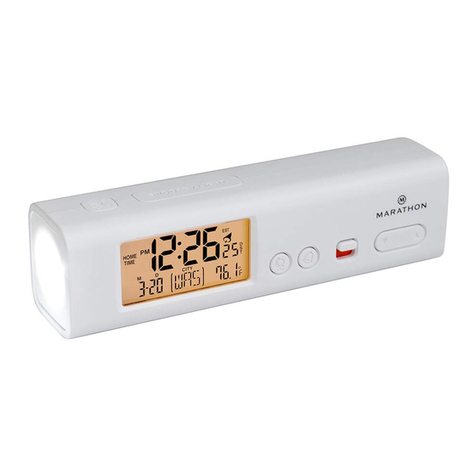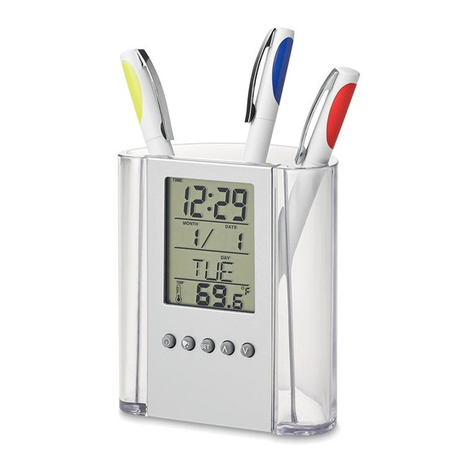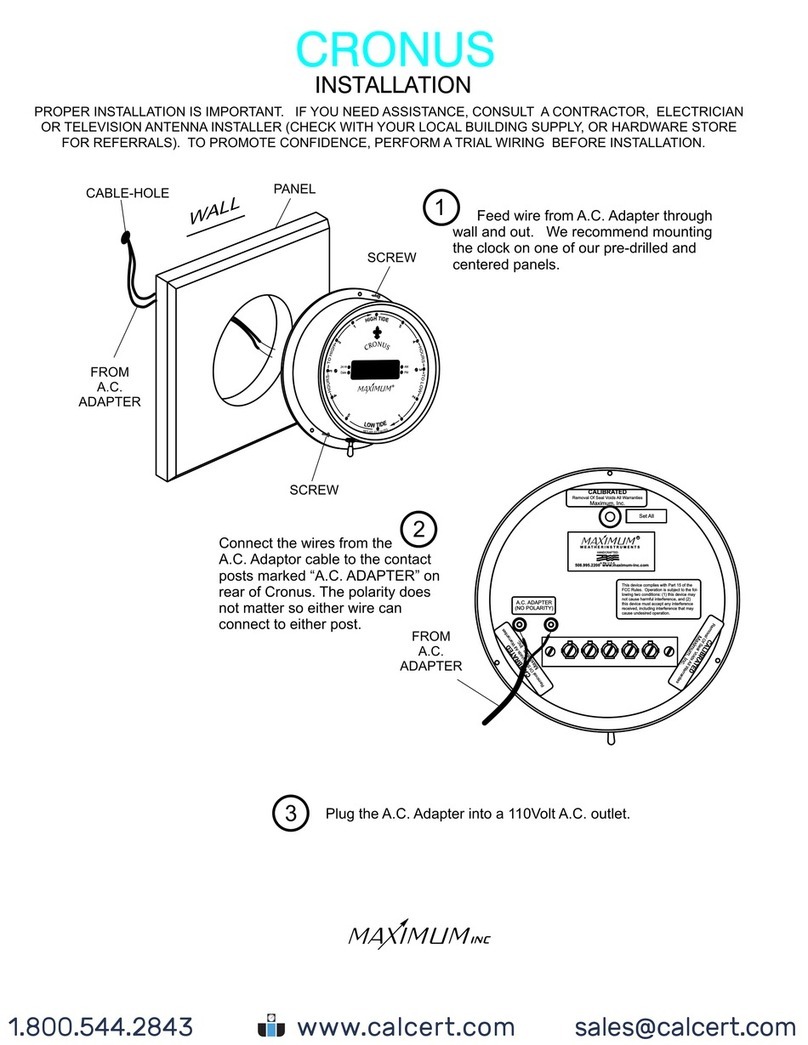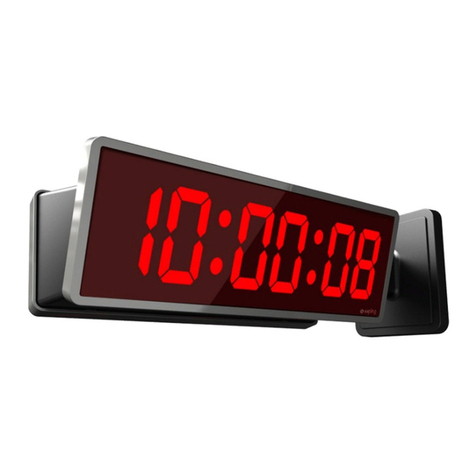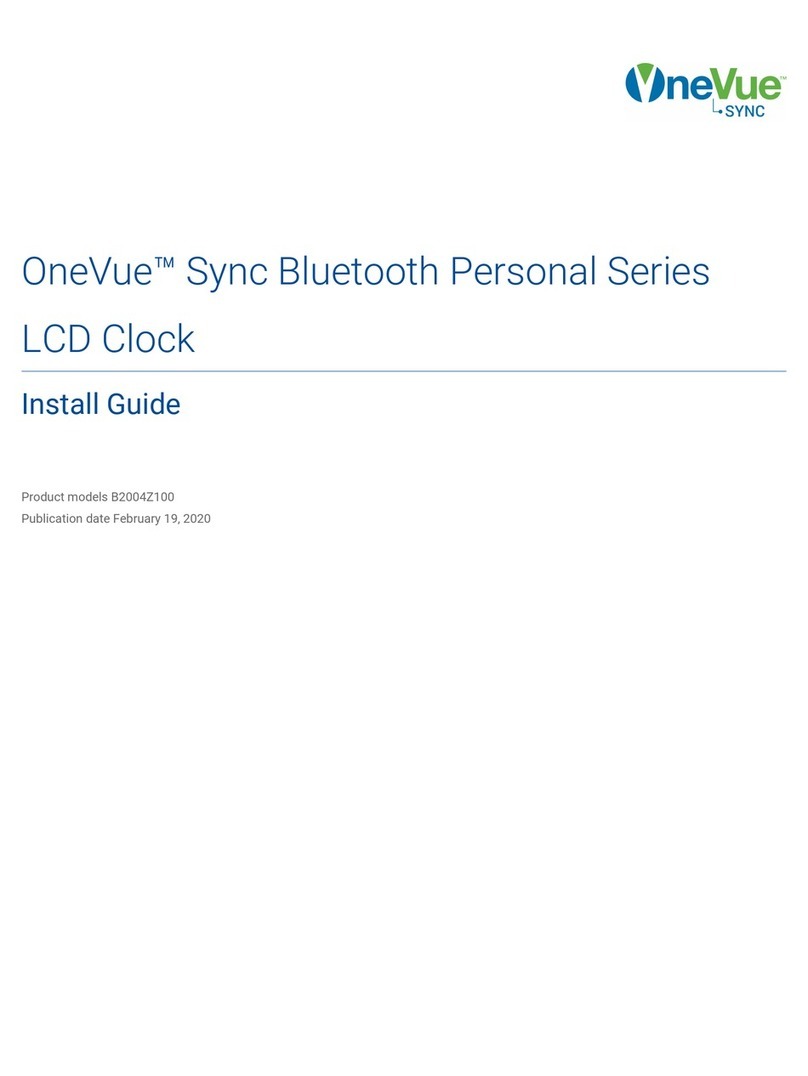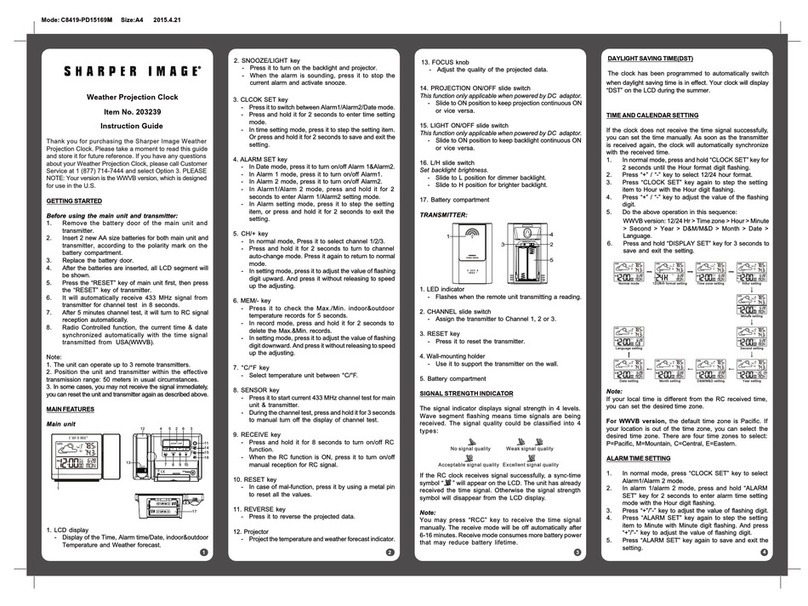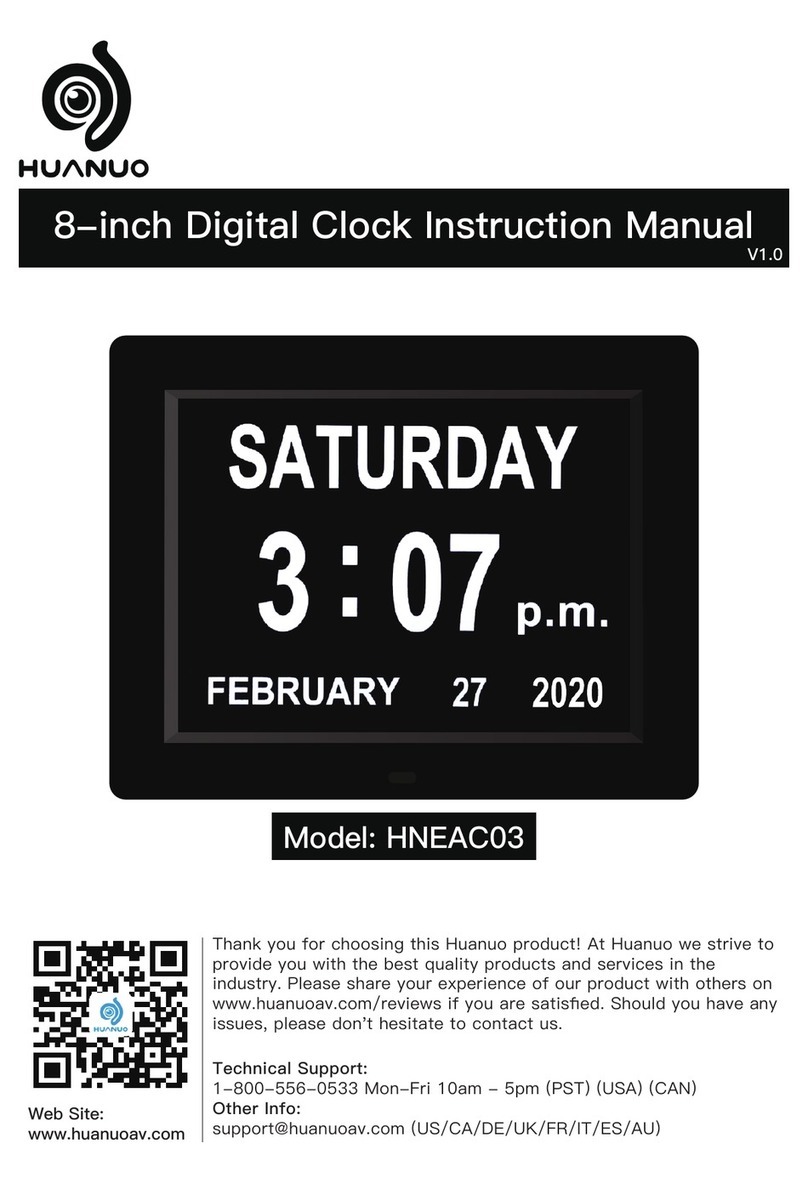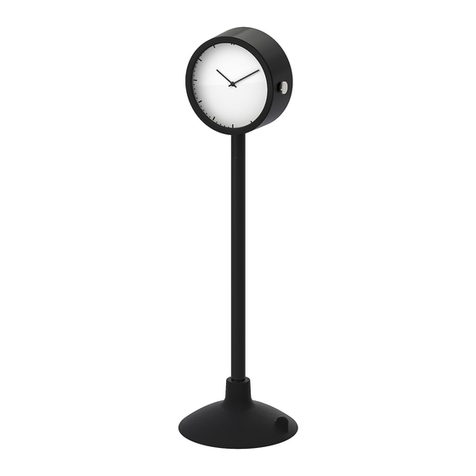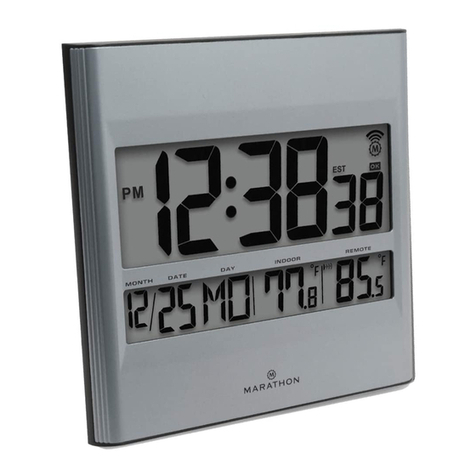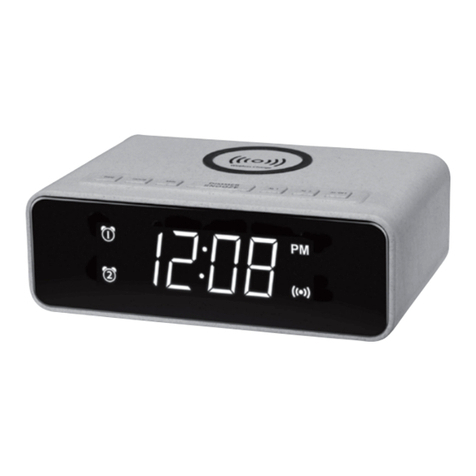Chelsea Clock SHIP’S BELL CLOCK AND BAROMETER User manual

PRODUCT MANUAL
SHIP’S BELL CLOCK AND BAROMETER
A Chelsea clock is an exquisite time machine. Each is a work of art handcrafted by elite master clockmakers. For more
than a century, Chelsea craftsmen have created instruments whose beauty and workmanship enhance their extraordinary
functionality and durability.
Chelsea clocks sail the seas with the United States military, grace the ocean’s most impressive yachts, and bear witness
to meetings of heads of state, presidents, princes, and kings of rock and roll. Chelsea clocks are treasured by collectors,
cherished from one generation to the next, and given as gifts to some of the luckiest people in the world.
Whether you purchased a handsome Chelsea clock or received one as a gift, you can be sure that Chelsea’s master
clockmakers have taken exceptional care to produce one of the world’s finest instruments.
Congratulations
The Ship’s Bell Clock
Two Hundred Eighty Four Everett Avenue, Chelsea, Massachusetts 02150-1515 | Tel 617 884-0250 | chelseaclock.com
SETTING THE TIME
Please note that the clock leaves our factory fully wound. To set the time, first remove the black tube from the winding
arbor in the front of the clock (save the tube and replace it when shipping the clock or are away for extended periods).
Next, turn the minute hand clockwise to the correct time, stopping at each hour and half-hour point to allow the bells to
strike their full count. The hour hand should never be moved manually; all adjustments should be made by moving the
minute hand.
When moving the minute hand, the correct strike count may not sound at the first chime point, but this will self-correct
at the next full-hour point. Do not force the hands when setting the time. If they lock at any point, turn the minute hand
backwards through one striking position, then continue as above.
Whether your clock has the Ship's Bell or House Strike* chimes, a “warn” occurs at 20 minutes past and 10 minutes
before the hour. This means that for the 10 minutes prior to each striking point, the gears and levers of the striking mecha-
nism fall into correct position. Thus it is advisable that whenever the striking clock is to be reset, the minute hand only
should be slowly rotated clockwise to the next striking point, and then the clock allowed to strike its full count. Adjust-
ments should never be made during a strike zone, only from 5 to 15 minutes past the hour or 25 to 15 minutes before the
hour.
*A House Strike chime is a traditional chime that usually strikes at the quarter hour.
WINDING THE CLOCK
Wind the clock fully weekly at approximately the same time. The left keyhole is for winding the strike mechanism and
the right one is for the clock’s mainspring. Be sure to wind both fully, starting with the left. If the clock has run down, it is
very important to wind it before moving the hands. If the minute hand is locked, the mechanism has jammed. To release
it, wind the clock fully on both sides, and then move the minute hand backwards one hour or more. Finally, reset the time
letting the clock strike at the hour and the half-hour points.
REGULATING THE CLOCK
All clocks are finely regulated when they leave our factory. However, environmental conditions, age, and other factors can
minutely affect their rate over time. You can compensate for a minor time gain or loss by adjusting the clocks microm-
eter regulator. A small wheel that appears in a slot in the clock’s face controls the regulator. Turn the wheel toward “F”
(faster) if the clock is losing time, and toward “S” (slower) if it is gaining time. Rotating the wheel one notch will change
the rate approximately four seconds per day. It is generally easier to let the clock run for a full week, then adjust the
regulator as needed.

Two Hundred Eighty Four Everett Avenue, Chelsea, Massachusetts 02150-1515 | Tel 617 884-0250 | chelseaclock.com
ADJUSTING THE TONE
The clear resonant tone of a Chelsea clock occurs when its controlled strike hammer drops onto a coiled steel gong. To
strike properly, the clock must therefore be in its natural upright position. To access the strike mechanism, wait until the
clock strikes the next full hour, then remove the back cover plate by unscrewing its three screws.
If the chime sounds ‘flat,” or fails to sound when the strike mechanism operates, the hammer’s head may be resting on,
or too close to, the gong coil. This is easy to correct by bending the hammer wire slightly upward, just enough so the
head does not touch the coil when at rest. Simply hold the wire while in the rest position (do not press down on it), and
carefully bend the hammer end with needle nose pliers or any rigid object. Then, with your finger lift and drop the ham-
mer wire again to hear its sound. This operation should only be performed on the hour position, never on the half hour.
Note: If striking does not occur at the hour and half-hour dial markings the clock must be returned to our factory for
correction
SILENCING THE CHIME
To silence the bells, slide the small pin near the “8” on the clock’s dial away from the bell symbol. Do not turn off the
chime while the clock is striking. To resume striking, slide the pin toward the bell. Be sure to move the pin fully in one
direction or the other to prevent jamming.
THE SHIP’S BELL CODE
Mariners have used a unique bell code to tell time at sea for hundreds of years. The code is based on the crew’s typical
workday routine while the vessel is under way. A ship at sea requires constant attention throughout the day’s twenty-
four hours. The day is therefore divided into six four-hour periods, each called a “watch.” Similarly, the crew is segmented
into three divisions. Division members then stand their individually assigned duties on two watches per day, with eight
hours off duty between watches. To rotate each division’s watch times, the Evening Watch is periodically divided into
two watches. These are called Dog Watches because they “dog” the watch schedule for all divisions ahead by one watch
period.
First Watch 8:00 p.m. to 12:00 a.m.
Mid-Watch (also Black Watch) 12:00 a.m. to 4:00 a.m.
Morning Watch 4:00 a.m. to 8:00 a.m.
Forenoon Watch 8:00 a.m. to 12:00 p.m.
Afternoon Watch 12:00 p.m. to 4:00 p.m.
Evening Watch 4:00 p.m. to 8:00 p.m.
The watch officer struck the ship’s bell every half hour to apprise the crew of the time. A single bell denoted the end of
the first half hour and one bell was added each half-hour. Eight bells therefore signaled the end of each four-hour watch.
Like centuries of seafarers, you’ll soon know the time when the clock chimes, even if you can’t see it.
8 bells 12:00 4:00 8:00
1 bell 12:30 4:30 8:30
2 bells 1:00 5:00 9:00
3 bells 1:30 5:30 9:30
4 bells 2:00 6:00 10:00
5 bells 2:30 6:30 10:30
6 bells 3:00 7:00 11:00
7 bells 3:30 7:30 11:30

HOW IT WORKS
A barometer measures changes in atmospheric pressure, which you can think of as the weight of the air above you.
Changes in atmospheric pressure at any given point typically foretell changes in the weather. Weather watchers there-
fore note a barometer’s reading, then observe how much and how fast the reading rises or falls. Rising pressure sig-
nals improving weather, while falling pressure portends deteriorating weather. Generally, a barometer works best when
mounted indoors where air pressure is the same as that outside, but the instrument is less subject to the elements.
The Chelsea barometer is an aneroid barometer. This means it measures atmospheric pressure mechanically, without
Mercury or other fluids. Instead it uses a vacuum and a hollow metallic diaphragm. Pressure changes on the diaphragm
cause the black indicator hand on the dial to move. You can manually position the stationary gold hand over the black
indicator hand, and return later to note how much the pressure has changed and whether it is rising or falling.
Barometers can measure atmospheric pressure in inches, millibars, or centimeters. At sea level, normal atmospheric pres-
sure is approximately 29.92 inches, 1014 millibars, or 76 centimeters. At higher elevations, the average pressure will be less
because there is less air pressure overhead. Normal weather variations cause the pressure to rise or fall an inch or less
so you may see little movement of the black hand for several days at a time. A passing storm often brings rapidly falling
pressure.
SETTING FOR LOCAL ALTITUDE
When a Chelsea barometer leaves our factory it is adjusted to register pressure at sea level, which is the standard way to
measure barometric pressure regardless of location or altitude. Since atmospheric pressure decreases as altitude increas-
es, if you are in a higher altitude location it will be necessary for you to adjust the barometer to give you a reading cor-
rected to sea level. To do this, call the local weather bureau and ask for the present barometer reading. Then adjust the
barometer’s black indicator hand to the reading given. This can be accomplished by turning the small screw on the back
of the barometer case. If you are at an altitude of 5,000 feet or greater, the barometer should be adjusted professionally.
CARING FOR THE CASE
Chelsea Clock cases are constructed of exceptionally high quality brass, highly polished to a fine finish, and then care-
fully lacquered for long-lasting protection. The chemicals in fingerprints and even ordinary dust may eventually mar
this finish. Therefore, we suggest cleaning the case weekly with a clean soft cloth. Do not use polish, cleaner, or other
liquids that could tarnish or pit the finish. Treated with this care, the lacquer coating will not be broken and the clock
case should retain its bright appearance for many years.
SERVICING THE CLOCK OR BAROMETER
Under normal operating conditions, the clock should be cleaned, oiled, and adjusted about every five to seven years.
Conditions such as extreme heat, cold, dust, and even idleness can adversely affect lubricating oils and therefore neces-
sitate more frequent servicing. A Chelsea clock or barometer is a precision instrument that should only be serviced by
our master clockmakers. When the clock or barometer requires cleaning or service, we urge you return it to our factory
repair center where an experienced master clockmaker will insure careful, efficient, and guaranteed work. Please take
extra care to double-box the clock to avoid damage in transit. You can find further packing and shipping advice online at
www.chelseaclock.com.
The Barometer
LIMITED WARRANTY
A new Chelsea Ship’s Bell clock or barometer is warranted against defects in material and workmanship for five (5)
years from the date of original purchase. In the event of any such defect, please return the instrument postage prepaid,
along with an explanation of the defect to the address set forth below and it will be repaired or replaced, at our option
and our expense. Any defect or damage caused by misuse, accident, tampering or negligence of the user is not covered
by this warranty. Be certain to carefully and securely pack the instrument for return. We will not be responsible for dam-
age in shipment. The repaired or replacement instrument will be returned to you postage prepaid. All implied warranties
covering merchantability, fitness for particular purpose, or otherwise are limited in duration to five (5) years from the
date of original purchase. The repair or replacement of any defect is the exclusive remedy under this warranty. In addi-
tion, the warrantor shall not, under any circumstances, be liable or responsible hereunder for consequential, incidental,
indirect or special damages. Please note that some states do not allow limitations on how long an implied warranty lasts,
or the exclusion or limitation of incidental or consequential damages, so the foregoing limitation or exclusion may not
apply to you. This warranty gives you specific legal rights; you may also have other rights that vary from state to state.
Two Hundred Eighty Four Everett Avenue, Chelsea, Massachusetts 02150-1515 | Tel 617 884-0250 | chelseaclock.com
Table of contents
Other Chelsea Clock Clock manuals

